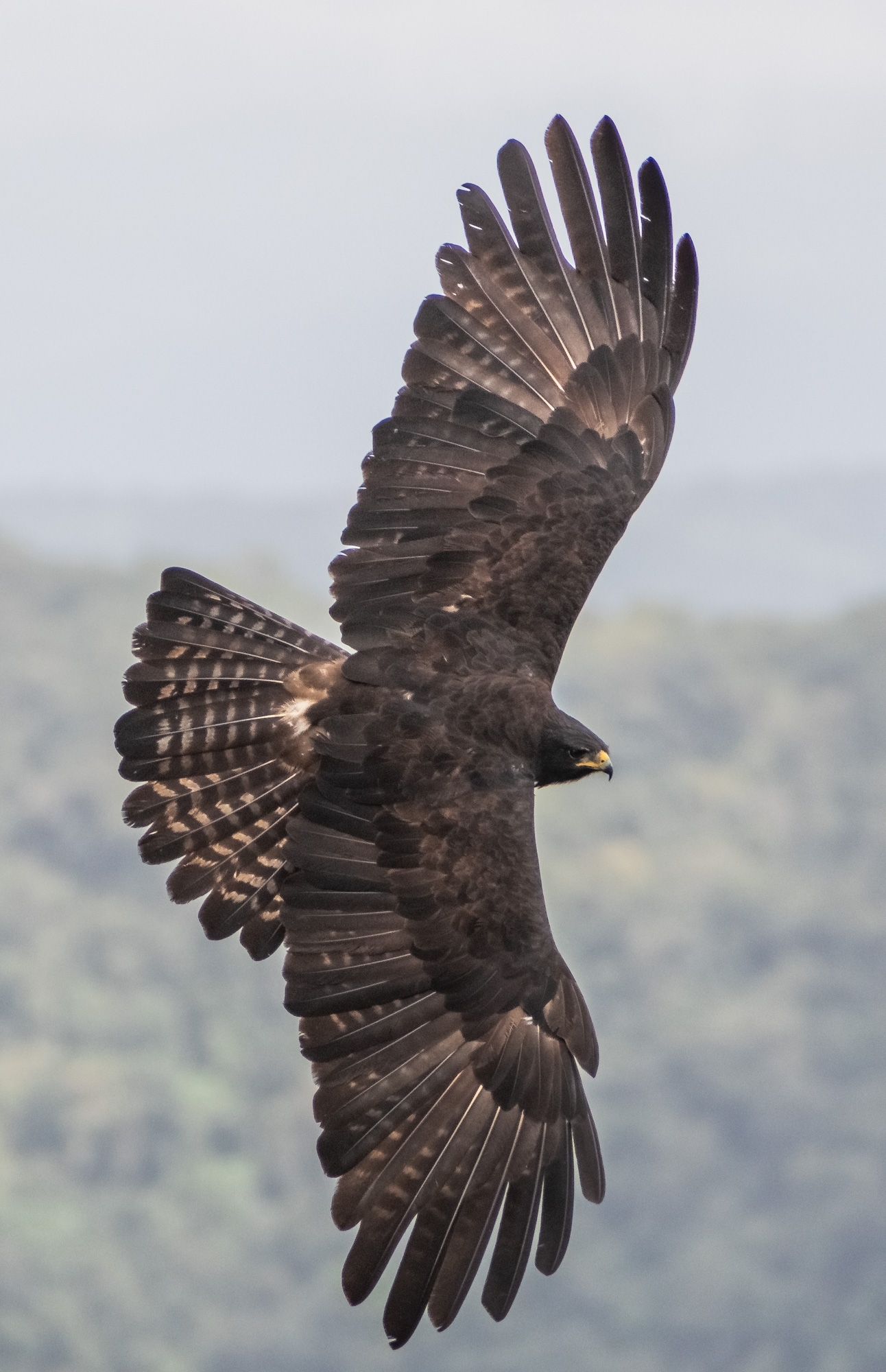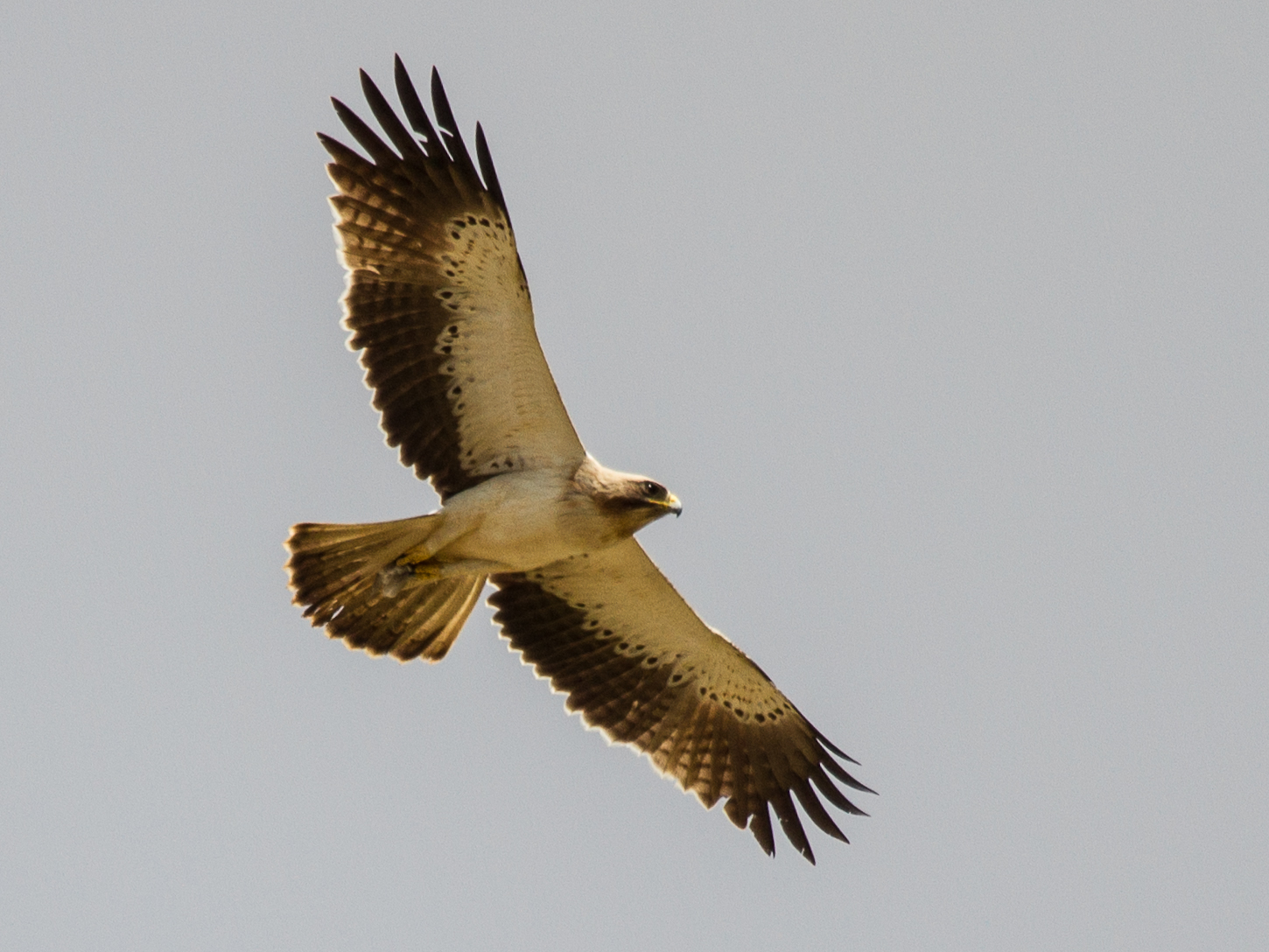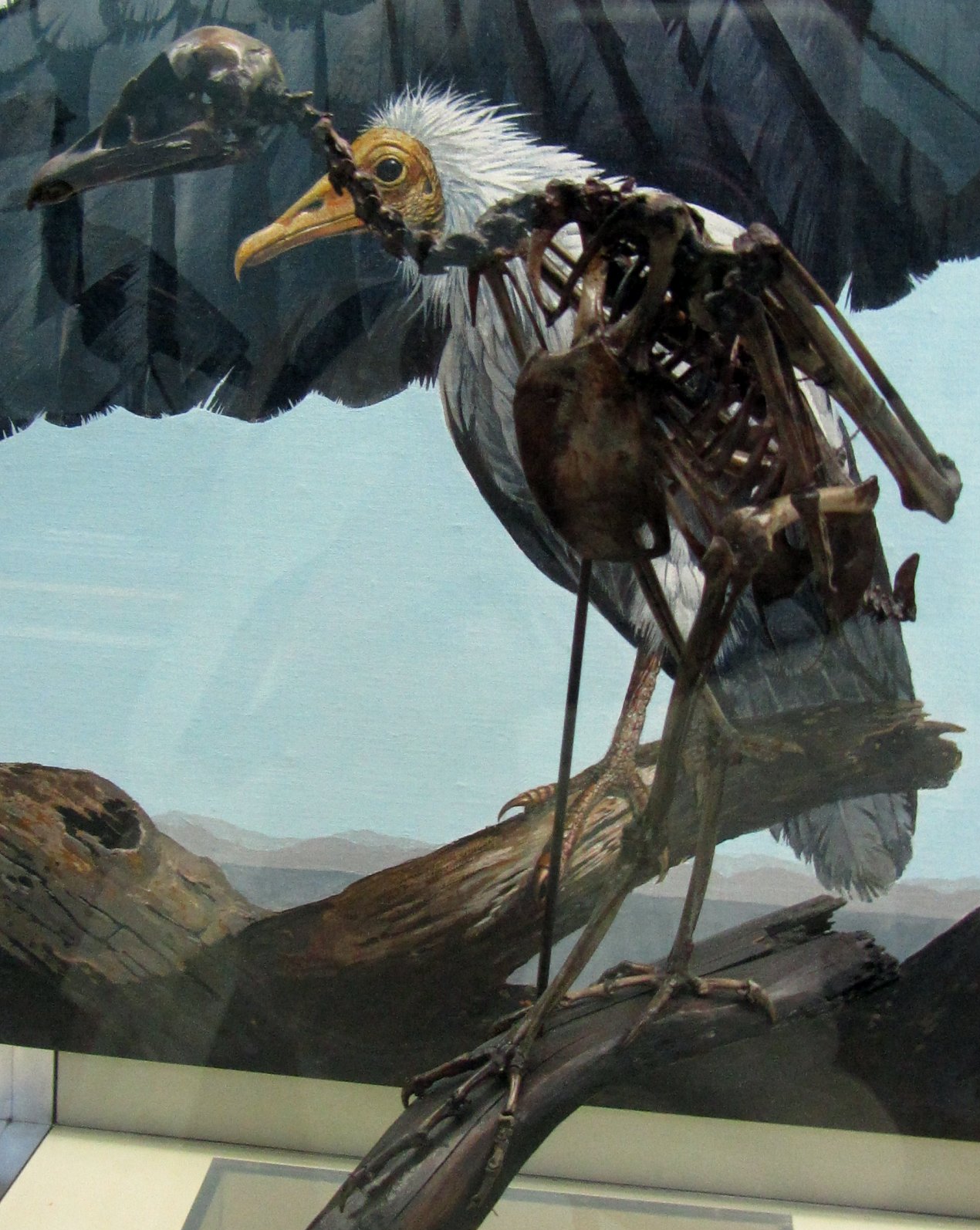|
Ictinaetus
The black eagle (''Ictinaetus malaiensis'') is a bird of prey. Like all eagles, it is in the family Accipitridae, and is the only member of the genus ''Ictinaetus''. They soar over forests in the hilly regions of tropical and subtropical South and Southeast Asia, as well as southeastern China. They hunt mammals and birds, particularly at their nests. They are easily identified by their widely splayed and long primary "fingers", the characteristic silhouette, slow flight and yellow ceres and legs that contrast with their dark feathers. Taxonomy and systematics The species name is spelt ''malayensis'' in most publications but the original spelling used by Temminck in his description uses the spelling ''malaiensis'' according to a 2011 finding of some of the original covers of the part publications leading to taxonomists applying the principle of priority and rejecting any later spelling emendations. A molecular phylogenetic study of the Accipitridae published in 2024 found that ... [...More Info...] [...Related Items...] OR: [Wikipedia] [Google] [Baidu] |
Eagle
Eagle is the common name for the golden eagle, bald eagle, and other birds of prey in the family of the Accipitridae. Eagles belong to several groups of Genus, genera, some of which are closely related. True eagles comprise the genus ''Aquila (bird), Aquila''. Most of the 68 species of eagles are from Eurasia and Africa. Outside this area, just 14 species can be found—two in North America, nine in Central and South America, and three in Australia. Eagles are not a natural group but denote essentially any kind of bird of prey large enough to hunt sizeable (about 50 cm long or more overall) vertebrates. Etymology The word "eagle" is borrowed into English from and , both derived ultimately from ("eagle"). It is cognate with terms such as , and . It is broadly synonymous with the less common English term "erne" or "earn", deriving from , from , in which it acts as the usual word for the bird. The Old English term is turn derived from and is cognate with other synonymous ... [...More Info...] [...Related Items...] OR: [Wikipedia] [Google] [Baidu] |
Accipitridae
The Accipitridae () is one of the four families within the order Accipitriformes, and is a family of small to large birds of prey with strongly hooked bills and variable morphology based on diet. They feed on a range of prey items from insects to medium-sized mammals, with a number feeding on carrion and a few feeding on fruit. The Accipitridae have a cosmopolitan distribution, being found on all the world's continents (except Antarctica) and a number of oceanic island groups. Some species are migratory. The family contains 256 species which are divided into 12 subfamilies and 75 genera. Many well-known birds such as hawks, eagles, kites, harriers and Old World vultures are included in this group. The osprey is usually placed in a separate family ( Pandionidae), as is the secretary bird ( Sagittariidae), and the New World vultures are also usually now regarded as a separate family or order. Karyotype data indicate the accipitrids analysed are indeed a distinct monophyletic ... [...More Info...] [...Related Items...] OR: [Wikipedia] [Google] [Baidu] |
Clanga (bird)
''Clanga'' is a genus which contains the spotted eagles. The genus name is from Ancient Greek ''klangos'', "eagle". Taxonomy The genus ''Clanga'' was described in 1854 by the Polish naturalist Adam Ferdynand Adamowicz (1802-1881). The type species is ''Falco maculatus'' J. F. Gmelin, 1788, a synonym of ''Aquila clanga'' (the greater spotted eagle) that was described in 1811 by Peter Simon Pallas. '' Falco maculatus'' J. F. Gmelin is preoccupied by ''Falco maculatus'' Tunstall 1771 but under the rules of the International Code of Zoological Nomenclature ''Falco maculatus'' is still considered to be the type species. The genus name is from Ancient Greek ''klangos'' meaning "eagle". A molecular phylogenetic study of the Accipitridae published in 2024 found that the genus ''Clanga'' was sister to the genus '' Ictinaetus'' which contains the black eagle The black eagle (''Ictinaetus malaiensis'') is a bird of prey. Like all eagles, it is in the family Accipitridae, and is the o ... [...More Info...] [...Related Items...] OR: [Wikipedia] [Google] [Baidu] |
Changeable Hawk-eagle
The changeable hawk-eagle ''(Nisaetus cirrhatus)'' or crested hawk-eagle is a large bird of prey species of the family (biology), family Accipitridae. More informal or antiquated English common names include the marsh hawk-eagle or Indian crested hawk-eagle.Ferguson-Lees, J., & Christie, D. A. (2001). ''Raptors of the world''. Houghton Mifflin Harcourt. It is a member of the subfamily Aquilinae, with signature feathers, absent in tropical raptors from outside this subfamily, covering the tarsus. It was formerly placed in the genus ''Spizaetus'', but studies pointed to the group being paraphyletic resulting in the Old World members being placed in ''Nisaetus'' and separated from the New World species. It is a typical "hawk-eagle" in that it is an agile forest-dwelling predator and like many such eagles readily varies its prey selection between birds, mammals or reptiles as well as other vertebrates.Naoroji, R., & Schmitt, N. J. (2007). ''Birds of prey of the Indian subcontinent''. Om ... [...More Info...] [...Related Items...] OR: [Wikipedia] [Google] [Baidu] |
Mountain Hawk-eagle
The mountain hawk-eagle (''Nisaetus nipalensis'') or Hodgson's hawk-eagle, is a large bird of prey native to Asia. The latter name is in reference to the naturalist, Brian Houghton Hodgson, who described the species after collecting one himself in the Himalayas. A less widely recognized common English name is the feather-toed eagle. Like all eagles, it is in the family Accipitridae. Its feathered tarsus marks this species as a member of the subfamily Aquilinae. It is a confirmed breeding species in the northern part of the Indian subcontinent, from India, Nepal (hence the epithet ''nipalensis'') through Bangladesh to Thailand, Taiwan, Vietnam and Japan, although its distribution could be wider still as breeding species. Like other Asian hawk-eagles, this species was earlier treated under the genera of ''Spizaetus'' but genetic studies have shown this group to be paraphyletic, resulting in the Old World members being placed in ''Nisaetus'' (Hodgson, 1836) and separated from the Ne ... [...More Info...] [...Related Items...] OR: [Wikipedia] [Google] [Baidu] |
Edward Blyth
Edward Blyth (23 December 1810 – 27 December 1873) was an English zoologist who worked for most of his life in India as a curator of zoology at the Asiatic Society, Royal Asiatic Society of Bengal in Calcutta. He set about updating the museum's catalogues, publishing a ''Catalogue of the Birds of the Asiatic Society'' in 1849. He was prevented from doing much fieldwork himself, but received and described bird specimens from Allan Octavian Hume, A.O. Hume, Samuel Tickell, Robert Swinhoe among others. His ''Natural History of the Cranes'' was published posthumously in 1881. Early life and work On 23 December 1810, Blyth was born in London. His father, a cloth merchant, clothier, died in 1820 and his mother sent him to Dr. Fennell's school in Wimbledon, London, Wimbledon. He took an interest in reading, but was often to be found spending time in the woods nearby. Leaving school in 1825, he went to study chemistry, at the suggestion of Dr. Fennell, in London under Dr. Keating at S ... [...More Info...] [...Related Items...] OR: [Wikipedia] [Google] [Baidu] |
Asia
Asia ( , ) is the largest continent in the world by both land area and population. It covers an area of more than 44 million square kilometres, about 30% of Earth's total land area and 8% of Earth's total surface area. The continent, which has long been home to the majority of the human population, was the site of many of the first civilisations. Its 4.7 billion people constitute roughly 60% of the world's population. Asia shares the landmass of Eurasia with Europe, and of Afro-Eurasia with both Europe and Africa. In general terms, it is bounded on the east by the Pacific Ocean, on the south by the Indian Ocean, and on the north by the Arctic Ocean. The border of Asia with Europe is a social constructionism, historical and cultural construct, as there is no clear physical and geographical separation between them. A commonly accepted division places Asia to the east of the Suez Canal separating it from Africa; and to the east of the Turkish straits, the Ural Mountains an ... [...More Info...] [...Related Items...] OR: [Wikipedia] [Google] [Baidu] |
Himalaya
The Himalayas, or Himalaya ( ), is a mountain range in Asia, separating the plains of the Indian subcontinent from the Tibetan Plateau. The range has some of the Earth's highest peaks, including the highest, Mount Everest. More than 100 peaks exceeding elevations of above sea level lie in the Himalayas. The Himalayas abut on or cross territories of six countries: Nepal, China, Pakistan, Bhutan, India and Afghanistan. The sovereignty of the range in the Kashmir region is disputed among India, Pakistan, and China. The Himalayan range is bordered on the northwest by the Karakoram and Hindu Kush ranges, on the north by the Tibetan Plateau, and on the south by the Indo-Gangetic Plain. Some of the world's major rivers, the Indus, the Ganges, and the Tsangpo– Brahmaputra, rise in the vicinity of the Himalayas, and their combined drainage basin is home to some 600 million people; 53 million people live in the Himalayas. The Himalayas have profoundly shaped the cultures of ... [...More Info...] [...Related Items...] OR: [Wikipedia] [Google] [Baidu] |
Himachal Pradesh
Himachal Pradesh (; Sanskrit: ''himācāl prādes;'' "Snow-laden Mountain Province") is a States and union territories of India, state in the northern part of India. Situated in the Western Himalayas, it is one of the thirteen Indian Himalayan Region, mountain states and is characterised by an extreme landscape featuring List of mountain peaks of Himachal Pradesh, several peaks and extensive river systems. Himachal Pradesh is the northernmost state of India and shares borders with the union territories of Jammu and Kashmir (union territory), Jammu and Kashmir and Ladakh to the north, and the states of Punjab (India), Punjab to the west, Haryana to the southwest, Uttarakhand to the southeast and a very narrow border with Uttar Pradesh to the south. The state also shares an international border to the east with the Tibet Autonomous Region in China. Himachal Pradesh is also known as ''Dev Bhoomi'', meaning 'Land of Gods' and ''Veer Bhoomi'' which means 'Land of the Brave'. The pre ... [...More Info...] [...Related Items...] OR: [Wikipedia] [Google] [Baidu] |
India
India, officially the Republic of India, is a country in South Asia. It is the List of countries and dependencies by area, seventh-largest country by area; the List of countries by population (United Nations), most populous country since 2023; and, since its independence in 1947, the world's most populous democracy. Bounded by the Indian Ocean on the south, the Arabian Sea on the southwest, and the Bay of Bengal on the southeast, it shares land borders with Pakistan to the west; China, Nepal, and Bhutan to the north; and Bangladesh and Myanmar to the east. In the Indian Ocean, India is near Sri Lanka and the Maldives; its Andaman and Nicobar Islands share a maritime border with Thailand, Myanmar, and Indonesia. Modern humans arrived on the Indian subcontinent from Africa no later than 55,000 years ago., "Y-Chromosome and Mt-DNA data support the colonization of South Asia by modern humans originating in Africa. ... Coalescence dates for most non-European populations averag ... [...More Info...] [...Related Items...] OR: [Wikipedia] [Google] [Baidu] |
Jammu And Kashmir (union Territory)
Jammu and Kashmir ( J&K) is a region administered by India as a union territory and consists of the southern portion of the larger Kashmir region, which has been the subject of a Kashmir#Kashmir dispute, dispute between India and Pakistan since 1947 and between India and China since 1959.The application of the term "administered" to the various regions of Kashmir and a mention of the Kashmir dispute is supported by the WP:TERTIARY, tertiary sources (a) through (e), reflecting WP:DUE, due weight in the coverage. Although "controlled" and "held" are also applied neutrally to the names of the disputants or to the regions administered by them, as evidenced in sources (h) through (i) below, "held" is also considered politicised usage, as is the term "occupied", (see (j) below). (a) (subscription required) Quote: "Kashmir, region of the northwestern Indian subcontinent ... has been the subject of dispute between India and Pakistan since the partition of the Indian subcontinent in 1 ... [...More Info...] [...Related Items...] OR: [Wikipedia] [Google] [Baidu] |








